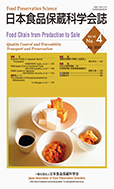
- Issue 6 Pages 269-
- Issue 5 Pages 217-
- Issue 4 Pages 153-
- Issue 3 Pages 103-
- Issue 2 Pages 57-
- Issue 1 Pages 3-
- |<
- <
- 1
- >
- >|
-
Asako HORINISHI, Ryo YUKIMOTO, Kohei HIGASHIDE, Kunihiro KISHIDA, Haji ...2017Volume 43Issue 4 Pages 153-162
Published: 2017
Released on J-STAGE: November 06, 2022
JOURNAL FREE ACCESSThe phenolic composition of fruit from the new cultivar of Japanese apricot (Prunus mume Sieb. et Zucc.), 'Tsuyuakane', was investigated. Comparison of phenolic contents among 'Tsuyuakane' and its parental cultivars suggested that the high level of anthocyanins in 'Tsuyuakane' is inherited from one of its parental varieties, 'Kasaharahatankyo', and its high level of chlorogenic acid derivatives is likely inherited from the other parental variety, 'Yousei-ume'. One of the characteristic phenolic compounds found in the fruit of 'Tsuyuakane' was neochlorogenic acid. Exogenous ethylene treatment of the fruit, which is known to increase the red color intensity of 'Tsuyuakane' fruit, increased not only anthocyanin levels but also neochlorogenic acid content. The existence of acetylated sucrose esters of hydroxycinnamates was suggested by LC-MS analysis. Moreover, the inhibitory effects of 'Tsuyuakane' phenolic compounds (TAP) on rat small intestinal disaccharidases and their suppressive effects on postprandial blood glucose levels in rats were evaluated. TAP inhibited maltase, glucoamylase, and sucrase in vitro. TAP delayed postprandial blood glucose level elevation when rats were fed with starch, however, no significant effect was observed upon administration with maltose or sucrose.
View full abstractDownload PDF (1332K) -
Kazuhiro MINAMI, Osamu KASHIMURA, Yuji MAEZAKI, Noriko KIYOYANAGI, Koi ...2017Volume 43Issue 4 Pages 163-170
Published: 2017
Released on J-STAGE: November 06, 2022
JOURNAL FREE ACCESSIn this study, we designed a noninvasive method to evaluate functional foods for improvements in endothelial function. Omega-3 fatty acids are known to exert cardio-protective effects, including improvement of endothelial function. Endothelial dysfunction is an early event in hypertension and arteriosclerosis, and can lead to blood pressure increases and formation of plaques that block blood flow. The flow-mediated vasodilation (FMD) response is considered to represent endothelial function. Oil from the seeds of Sacha-inchi (Plukenetia volubilis L.) contains 45.5% α-linolenic acid (ω3) of total fatty acid content, while canola oil contains only 9.7% α-linolenic acid. Twenty healthy subjects (10 males and 10 females; age 21.6 ±0.83 years) were given a single dose of 350mg Sacha-inchi oil or canola oil. FMD of the subjects was 11.2 ±2.53% at baseline. Three hours after ingesting Sacha-inchi oil, the FMD of the subjects increased to 17.2 ±1.82%. Ingesting canola oil resulted in an FMD increase to only 11.7 ±2.05%. These findings suggest that Sacha-inchi oil can improve endothelial function. We suggest that FMD-based evaluation of functional foods is a viable tool for assessing their efficacy in promoting human vascular health.
View full abstractDownload PDF (566K) -
Ryoichi MINOSHIMA, Kiwamu SHIIBA2017Volume 43Issue 4 Pages 171-177
Published: 2017
Released on J-STAGE: November 06, 2022
JOURNAL FREE ACCESSγ-Aminobutyric acid (GABA) was widely present in many legumes. Soybean GABA was present in fully mature stages, but productions also occurred during both the germinating and the grain embryo stages. Soybean GABA was produced in both immature legumes pod shells and seeds. Soybean GABA and glutamate may be produced in pod shells in early embryo stage and accumulated in seed during the late embryo stage. Soybean GABA was produced in immature legumes pod shells, possibly because of germination and / or reductive enzymatic conditions. Comparisons of chemical properties of the GABA contents between germinated and immature soybean reveled an optimum temperature difference for GABA production of 20℃. The optimum pH for the germinated soybean slurry was similarly pH 6, but the immature soybean slurry was stable at a wider pH range. These results may indicate that two different GAD isomers existed during soybean growth.
View full abstractDownload PDF (296K) -
Mengqiu LI, Yukitaka MIYAZAWA, Gang ZHAO, Koichi SUZUKI, Yasushi KAWAI ...2017Volume 43Issue 4 Pages 179-186
Published: 2017
Released on J-STAGE: November 06, 2022
JOURNAL FREE ACCESSUtilization of a newly synthesized disaccharide, N-acetylsucrosamine (SucNAc; Fruβ2-1αGlcNAc), by bifidobacteria was studied by culturing bifidobacteria in SucNAc-containing GAM (40) broth and monitoring growth over time. Three bifidobacteria strains that demonstrated higher growth in SucNAc-containing culture medium compared to growth in standard GAM (40) culture medium were investigated in more detail. The growth characteristics of one of these strains, Bifidobacterium longum strain No. 14-2, was studied using semi-synthetic medium containing both glucose (0.12% w/v) and SucNAc (0.5% w/v). This strain stopped growing after 12 hours of incubation (Growth Phase 1), following glucose depletion and before any SucNAc was utilized. After 36 to 48 hours incubation, Growth Phase 2 began, with SucNAc consumption and hydrolysis (diauxic growth). Although this strain cannot utilize SucNAc on its own, it could utilize SucNAc in the presence of glucose.
Cell-free extracts were prepared after culturing Bif. longum strain No. 14-2 with i) a single carbon source (either glucose or sucrose), and ii) a mixed medium of glucose and SucNAc. Analysis of the hydrolyzing activity of the cell-free extract towards various sugars (disaccharides and oligosaccharides) found no hydrolyzing activity when glucose or sucrose was used as the single carbon source. In contrast, when grown in the presence of both glucose and SucNAc, the cell-free extract showed a wide range of hydrolyzing activity towards disaccharides and oligosaccharides, including the newly synthesized SucNAc.
Elucidating the mechanism underlying this utilization is important for understanding the diverse sugar-utilization abilities of bifidobacteria.
View full abstractDownload PDF (262K) -
Shigeno KUNISHO2017Volume 43Issue 4 Pages 187-191
Published: 2017
Released on J-STAGE: November 06, 2022
JOURNAL FREE ACCESSDownload PDF (2659K)
- |<
- <
- 1
- >
- >|